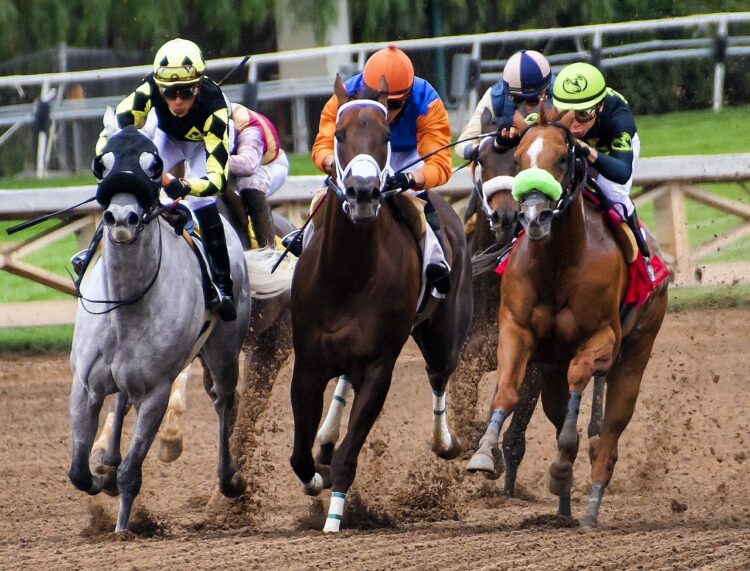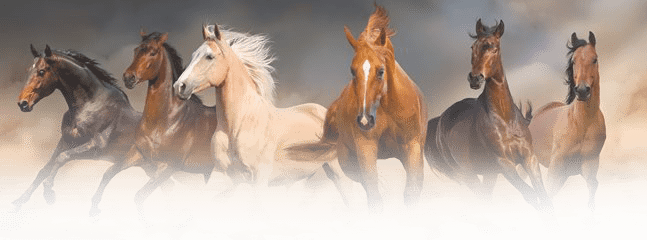Image Source
There’s something truly thrilling about watching a horse race. The thundering hooves, the cheering crowd, the sheer speed of it all. But have you ever stopped to ponder what really determines the outcome? It’s not just about which horse is fastest or which jockey is most skilled – there’s so much more to it.
In fact, factors like the track surface and the weather play huge roles in shaping the race. Ever noticed how some horses seem to glide effortlessly over a muddy track while others struggle? Or how can a gusty day turn a predictable race on its head?
In this guide, we will explore how these external elements can dramatically influence the horse’s performance and determine who’s going to cross the finish line first.
How Surface Affects Race Outcomes
You see, not all tracks are created equal. We’ve got three main types of tracks: dirt, turf, and synthetic. Let’s discover how each type of track affects race outcomes.
Dirt Tracks
Predominantly used in North American racing, dirt tracks tend to be faster than turf. However, they can also be harder on a horse’s body due to their firmness. Dirt tracks can kick up a lot of dust, which can affect visibility for both horses and jockeys.
Dirt tracks like the one in Gulfstream Park, which will host the Pegasus World Cup 2024, will likely favor horses adept at racing on such surfaces. So, seeing Nimitz Class and NY Traffic among the TVG picks for Pegasus 2024 wouldn’t be surprising.
Turf Tracks
Traditionally used in European racing, turf tracks offer a soft, forgiving surface that can be kinder on a horse’s legs. However, they are heavily influenced by weather conditions. When wet, turf can become slippery, requiring horses to have good balance and agility. Some horses, like the legendary Frankel, are known as “turf specialists” because they excel on this surface.
Synthetic Tracks
A more recent innovation is synthetic tracks, which are designed to mimic the best qualities of turf and dirt. They’re engineered to be safer, reducing the risk of injury by providing a uniform surface that handles weather changes well.
These tracks require a horse to have a blend of speed and endurance. Horses like Winx demonstrate versatility by excelling on both traditional and synthetic surfaces.
The Impact of Weather on Horse Racing
Now, let’s talk about another game-changer in horse racing – the weather. You might be surprised to learn just how much the weather can alter the outcome of a race. It’s not simply about whether it’s a sunny or rainy day. Each weather condition brings its own set of challenges and opportunities for our equine athletes.
1. Rain
Rain can drastically change the track’s surface from a fast, dry track to a slow, heavy, and slippery one. This alteration can advantage or disadvantage certain horses. Some horses, known as “mudders”, have a proven track record of performing well in wet conditions, while others may struggle. Additionally, heavy rain can decrease visibility for jockeys, making it harder to judge distances and potentially increasing the risk of mishaps.
2. Snow
Snow often leads to cancellations due to safety concerns. Even without snow, cold temperatures can affect horses physically. The cold can stiffen a horse’s muscles, reducing its performance level. Furthermore, breathing in cold air can be challenging for some horses, affecting their stamina.
3. Heat
High temperatures pose significant risks. Horses can overheat quickly, leading to dehydration, heat exhaustion, or even heat stroke.
These conditions can severely affect a horse’s performance and, in extreme cases, could be life-threatening. Many race courses will reschedule races to earlier or later in the day when temperatures are lower to protect the welfare of the horses.
4. Wind
Wind direction and speed can significantly impact a race. A strong headwind can slow horses down, while a tailwind can increase the overall speed of the race. This can upset predictions based on a horse’s known speed or stamina. Crosswinds can unbalance horses and make steering more challenging for the jockey, which can also affect the result of the race.
The Role of Jockeys in Adverse Weather Conditions
Jockeys play a pivotal role in navigating adverse weather conditions during races. An experienced jockey understands how to adjust their strategy based on the weather. For instance, in rainy conditions, they might choose to avoid the inside of the track if it’s particularly muddy. In strong winds, they may position their horse behind others to reduce wind resistance.
Understanding the comfort level of their horse in various weather conditions is also crucial. Each horse responds differently to weather changes. Some might excel in wet conditions, while others may struggle. Recognizing these nuances can guide a jockey’s decision-making and race tactics.
For example, in extreme heat, jockeys must carefully manage their horses’ energy levels to prevent overheating and ensure safety. During cold weather, keeping the horse’s muscles warm and loose is essential to prevent stiffness.
Takeaway
The interplay of weather conditions, a horse’s adaptability to them, and a jockey’s skill in navigating them significantly impact race outcomes. These factors add an unpredictable element to horse racing, making it more challenging but also more thrilling. Therefore, a deep understanding of these elements is crucial for anyone looking to predict or influence the outcome of a horse race. It’s not just about speed and form but also about adaptability and strategy.






















